An Invitation to Join ‘The Champagne Society’
JOIN THE CHAMPAGNE SOCIETY
Subscribe to our bimonthly Champagne Club. Please, call us at 248-398-0030 or email elie@eliewine.com
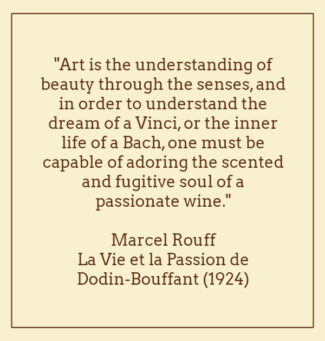 As a member of The Champagne Society, you’re in a select community of like-minded folks who appreciate the exceptional in life and recognize that sparkling wine is a superlative among man’s culinary creations. A bottle of Champagne is selected for you bimonthly. You will be drinking some of the best Champagne ever produced.
As a member of The Champagne Society, you’re in a select community of like-minded folks who appreciate the exceptional in life and recognize that sparkling wine is a superlative among man’s culinary creations. A bottle of Champagne is selected for you bimonthly. You will be drinking some of the best Champagne ever produced.
All selected wines are from passionate grower-producers or small houses deeply connected to the subtleties of each of their vine parcels and who believe that wine is made in the vineyard. Many of these wines are highly allocated, many bought directly, and we quite often only have access to a few cases of a particular cuvée.
As a member of The Champagne Society expect the following benefits:
• The selected Champagne quite often is not available in any other wine shop in Michigan and only in a few places, if any, in the country. We compete with savvy wine buyers in the European and the Far East markets to secure some of the allocations from these sought-after makers.
• The selection is released every other month and ready for pickup by the 10th of that month, or shipped if you prefer. Expect a new bottle in February, April, June, August, October and December.
• The price is always less than $100 and reflects 15% discount of the store price when we have additional quantities to sell to non-members. Champagne available, members may purchase any number of additional bottles at the same discounted price.
• We notify you via email when the installment selection is released in a newsletter that profiles the producer and the cuvée chosen. The newsletter is also posted on www.eliewine.com . Only then your credit card is charged and you are sent a separate purchase receipt.
• You can pause or cancel your membership at any time.
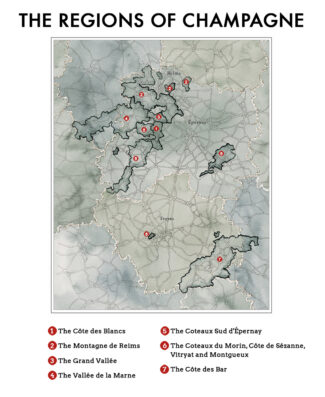
THE CHAMPAGNE SOCIETY DECEMBER 2021 SELECTION
Champagne Fleury
Ecological Pioneer with Purpose and Passion
(Côte des Bar)
Cépages Blancs Extra-Brut 2010 OR Sonate 2012 Extra-Brut ‘Natural’ *
*Special Price for members of the Champagne Society is $88. Not available to non-members (Sold out). Six other cuvées are available. See end of newsletter.
The Côte des Bar is located in the southern part of the Champagne production area, where climate, geography and careful vine husbandry combine to produce delicate, aromatic wine that is highly prized among the master blenders of Champagne’s most heralded labels. The land itself is a patchwork of vineyards planted on Jurassic slopes that overlie limestone bedrock with multiple exposures; the lush valleys that predominate throughout the Côte des Bar connect with those of the Seine and the Aube. The region encompasses 62 villages (divided between sub-regions Bar sur Abois and Barséquanais) and contains about 20,000 acres planted primarily to Pinot Noir, with about 12% Chardonnay and another four percent of Meunier.
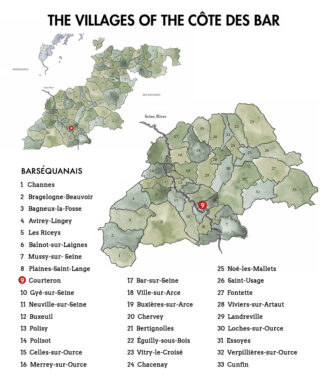
In the Côtes de Bar, Fleury plays two roles; it is a star long established in the Champagne heavens and a new star rising. In 1929, at the outset of the Great Depression, wholesale grape prices fell so sharply that grower Robert Fleury decided to start bottling his own Champagne. The estate itself had been founded nearly three decades earlier in Courteron, in the Aube district, where two rivers once converged to form the Seine. These ancient waters created slopes on which the Fleury family now owns ten plots, a total of forty acres planted primarily to Pinot Noir. The oldest vines were planted in 1970, and new cuttings are established every year to maintain the vitality that younger vines bring to Champagne.
Biodynamics are key to the current ideology at Fleury, pioneered by Jean-Pierre Fleury, whose interest in sustainable farming began in the 1970s when he tried using manual tilling (as opposed to herbicides) and composting (as opposed to synthetic fertilizers). He began a trial with biodynamics on a few acres, and in 1992 used it across the whole of his vineyard holdings. Today, his son Jean-Sébastien Fleury carries on the mission, understanding that at its most basic definition, ‘terroir’ means soil. “The key is soil health,” he maintains. ‘We must keep the earth healthy. The structure of the soil gives back the essence of the terroir’
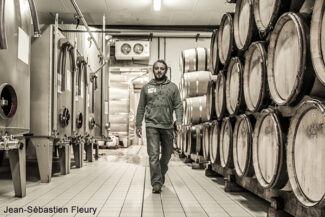
Appreciate the Balance and Share the Mysteries of Nature
The Japanese have long espoused a mystical connection between the earth and sky; a spectacle of nature and the subtle balance that prevails between tradition and modernity. That is a philosophy that winemaker Jean-Sébastien Fleury, only twenty-three years old, grew up with. His father, Jean-Pierre, who originally wanted to be an astronomer, embraced the concept that every human on earth has a small but essential role in maintaining the harmony of the universe, and fell in love with cultures founded on principles of equity, between people and with the land, and decided early to raise his family in physical and spiritual health.
Champagne is especially suited to this thought process; at its core, it is an attempt to find a nearly magical equilibrium between nature and man’s ability to enhance it. An understanding of the microcosm and the macrocosm is essential to a biodynamic vision, and as an homage to the interdependence of earth and sky, Fleury vineyard practices seemed—in the last century—as almost druidic, although they are now being embraced throughout France.
Enhancing and Understanding Terroir’s Character
Champagne is uniquely situated to take advantage of a multitude of superlatives in land and sky; the relatively northerly latitude and nearness to the ocean subject it to dual climates, oceanic and continental. The soil is a mosaic, structured with a subterranean limestone layer that acts to retain moisture and allows grapes to thrive in dry seasons and survive droughts. Combined with good hillside drainage, Jean-Sébastien Fleury wisely touts this topographical advantage: “The subsoil here is even more important to the vines than the soil.”
He goes on to explain that the silica in the earth produces lightness and aromatic finesse in a wine, whereas the marly and clay limestone beneath the surface adds alcoholic strength. “The closer the rock is to the surface,” he says, “the finer the Champagne.”
The estate is near the Plateau of Langres, and Fleury says that this is equally important to the signature terroir. But, as always, it is the touch of man that produces Champagne in concert with climate and soil. “Incorporating all these factors strengthens our knowledge of nature’s rhythms and improves the care we give to the plants and fruits so that the terroir reveals its character.”
The Biodynamic Principles: Respecting Earth’s Life Forces
The Fleury family looks at the estate as a living organism and pampers it as one might a beloved family pet. “We have been cultivating our land in line with its habitat for more than thirty years, acknowledging nature’s rhythms and the influence of terrestrial and cosmic forces. At first, this agricultural principle may seem demanding and esoteric, but it is truly a virtuous circle. We envision wine as a support of nature’s creation and undeniably enhances the product we bottle.” All wines are labeled ‘Organic Agriculture TM’ and ‘Biodynamic.’
Fleury delves deeper: “A vineyard is a monoculture, so our work is directed toward increasing biodiversity. Our viticultural work is focused on both the soil and the plant. Cultivation is done by hand in addition to the application of biodynamic preparations. Vine work is synchronized with planetary and lunar cycles; this is based on the effects these heavenly bodies have on root, leaf, flower and fruit development. For example, vine suckering, de-leafing and de-budding is done on ‘leaf day’ in the lunar calendar. The grafts and harvest is done in accordance with the lunar spring, when the moon is rising, a time that favors heavy sap flow. The lunar fall, when the moon is descending, is the best time for pruning.”
Vinification and the Winery: Producing Earth’s Best
In keeping with this overall view, Jean-Sébastien considers Fleury wine to be an expression of harmony; the earth’s quintessence. And yes, according to the estate’s vinification guidelines, the bottling is done on earth’s ‘fruit day.’ Before that, the grapes, hand-picked, are crushed and pressed in two 4000 kg. wooden hand-presses, and a third which is automated. Champagne production is, by its nature, labor intensive, but to make it even more exacting (and labor be damned) the Fleury family vinifies each of their ten lots separately, allowing them to better track the quality of the fruit from individual parcels. “Like a painter with a palette of colors, we assemble cuvées from grapes with different characteristics based on terroir and history.”
After fermentation, the wine remains on its lees until spring, and is first tasted at the spring equinox, and again in late April; these are critical steps wherein the wine is carefully evaluated before assembling the blend. In a system known as ‘inverse solera’, they then blend raw wine from the previous vintage with reserved wine from previous years, saving a portion of the new wine to top off the stock. This is a variation on the classic method for assembling Sherry: ‘La Solera inversée’ is a unique approach, and Jean-Sébastien is credited with creating a ‘time library’ of foudres containing earlier vintages housed in a timber-framed gallery.
The cuvées are aged with circumspection; three to five years for the Blanc de Noirs, Rosé and Fleur d’Europe and up to ten years for the Millésimes. As in all things ‘Fleury’, even the downtime of aging carries with it metaphysical symbolism, and it is referred to as ‘returning the product to its original land’ before exposing it to light again during the tasting. In the end, all elements harmonize, revealing the purity of process and the subtlety of nature.
Due to limited releases members will be assigned one of the following cuvées:
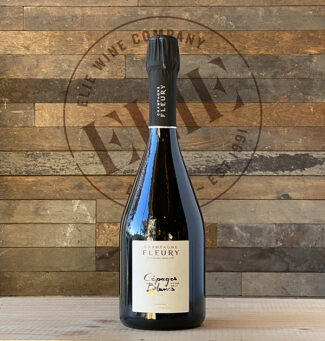 ‘Rainbow White’
‘Rainbow White’
Cépages Blancs Extra-Brut 2010 ($88)
An exclusive Blanc de Blanc made from the estate’s best plots of Chardonnay (Champraux and Valprune), where old vines have penetrated deeply into the Kimmeridgian subsoils. 2010 was a fairly difficult year in Champagne, with dry conditions retarding grape development early in the season. When rain arrived in August it was torrential, causing widespread disease pressure, but Chardonnay fared very well where Pinot Noir did not. The return of dry conditions in September was a godsend, but meticulous vignerons like the Fleury family understood that sorting in the vineyard and winery was crucial. The wine itself is majestic, with notes of white flowers, acacia honey, brioche, toasted bread rolls and dried stone fruits.
OR
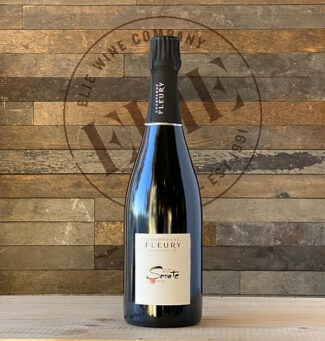 ‘The Music of Time and Space’
‘The Music of Time and Space’
Sonate 2012 Extra-Brut ‘Natural’ ($88)
A somewhat traditional Champagne blend—78% Pinot Noir and 22% Chardonnay—the cuvée is a splendid showcase for the exceptional 2012 vintage, where frost and hail reduced yields early in the season, and a warm summer produced exemplary acidity and grape health in the fruit that remained. ‘Sonate’ resonates with a blend of 35-year-old vines from the Champraux and Charme de Fin plots; it opens gradually and quickly improves, showing perfect balance between acidity, softness and tannins. Brown spices appear quickly, with nutmeg suggesting mature tones while acids provide a ghost of freshness. Beyond this, the palate is rich with bright cherry, apple crisp and honeyed croissant.
Champagne Fleury’s other cuvées …..
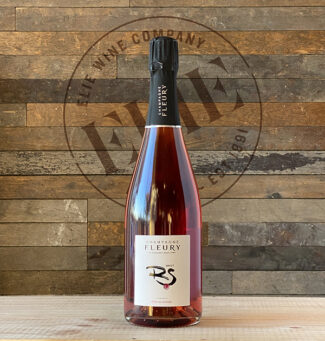 ‘When Mars Meets Venus’
‘When Mars Meets Venus’
‘Rosé de Saignée’ 2015 Brut ($68)
Winemaker Notes:
100% Pinot Noir from 30-year vines. Color is obtained by short maceration of the grapes before pressing. Malolactic fermentation. No dosage.
This wine has a bright ruby tinted color. With a delightful bouquet of fresh red fruits, blackcurrants and plum pie, the aromas combine both richness of vinosity. Aging potential is between 3 and 5 years.
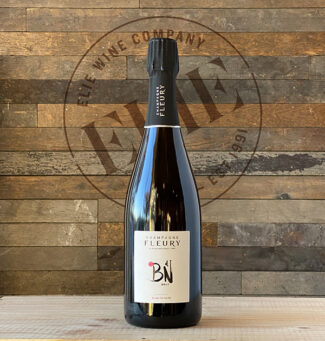 ‘Pinot Noir Planet’
‘Pinot Noir Planet’
‘Blanc de Noirs’ Brut ($55)
Winemaker Notes:
100% Pinot Noir. Originally created in 1955 by Robert Fleury, we changed the name of our classic cuvée to “Blanc de Noirs Brut” in 2010. Every new vintage is added to the previous vintage to create a perpetual reserve in large casks, a process also known as the “Solera” method. The cuvée is then aged “sur lattes” for four years. Blending 2016 (30%) and reserve wines (70%) with fermentation completed in thermo-regulated tanks and wooden tuns for reserve wines. Malolactic fermentation. Dosage is 3.6 grams/liter.
This pure Pinot Noir with straw-gold tints reveals an elegant and expressive nose, with delicate aromas of white peach and iris. Fresh on the palate with a crisp structure and lasting fruity flavors. Aging potential is between 3 and 5 years.
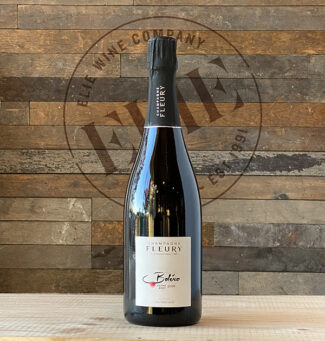 ‘The Notes of Twilight’
‘The Notes of Twilight’
‘Boléro’ 2009 Extra-Brut ($115)
Winemaker Notes:
100% Pinot Noir from 25-year old vines in Charme de Fin, Côte de Champraux, Meam Bauché and Montégné parcels. Last in production in 1990, this cuvée made a reprise in 2004. Fermentation is completed in thermoregulated tanks (50%) and oak barrels (50%). Malolactic fermentation is in the bottle under cork with ‘agrafe’. Residual sugar is 3.2 grams/liter naturally with no dosage.
The vintage expresses an array of complex aromas, dried fruits, toasted almonds, apricots, followed by herbaceous and mineral notes. On the palate we find flavors of freshly baked-bread, and juicy grapes, with a crystalline effervescence. Aging potential is between 5 and 10 years.
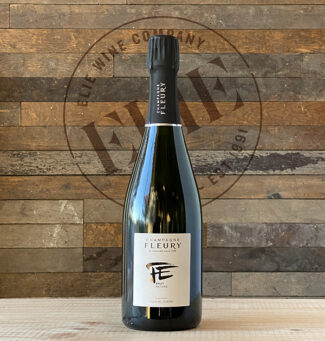 ‘The Sun has a Meeting with the Moon’
‘The Sun has a Meeting with the Moon’
‘Fleur de l’Europe’ Brut Nature ($60)
Winemaker Notes:
85% Pinot Noir and 15% Chardonnay. The first ever biodynamic cuvée in Champagne! The Europe which witnessed the fall of the Berlin Wall inspired the name of this wine. The ethereal and floral Chardonnay brings a special elegance to this cuvée. Despite at first receiving a dosage, it has been zero-dosage for the last 10 years. Blending 2014 (75%) and reserve wines (25%) with fermentation completed in thermoregulated tanks and oak barrels. Reserve wines are aged in oak tuns. Malolactic fermentation. No sugar added.
A Brut Nature Champagne, expressive with exceptional finesse! A bright gold robe carries aromas of honey and acacia. The mouthfeel is ample and generous with a surprising freshness. This is a chiseled wine, mouth- wateringly vibrant, with a touch of salinity. Aging potential is between 3 and 5 years.
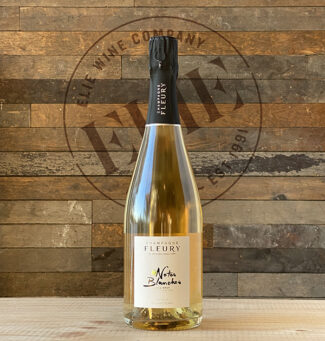 ‘Memories of a Star’
‘Memories of a Star’
‘Notes Blanches’ 2014 ($93)
Winemaker Notes:
100% Pinot Blanc from 25-year old vines in Charme de Fin and Valverot parcels. Although a variety in Champagne, Pinot Blanc has typically only been found in blends. However, in 2009 this rare, expressive and exotic variety was granted its own pure mono-varietal cuvée. Free of any dosage, this is definitely one to discover! No dosage.
On the palate there is an ample bouquet with aromas of yellow fruits and white pepper, enveloped by a supple texture and an energetic finish. Aging potential is between 3 and 5 years.
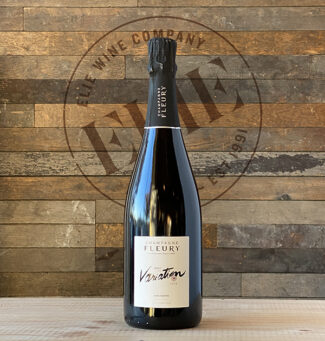 ‘Return of the Eclipse’
‘Return of the Eclipse’
‘Variation’ 2014 Brut ‘Natural’ ($130)
Winemaker Notes:
100% Pinot Gris. As a result of its vinification in oak, this wine has a powerful and complex nose, with a unique blend of aromas, yellow fruits, tropical fruits, and almonds. Fresh and crisp on the palate this wine is full of aromatic delights, which are enveloped by an ample mouthfeel and a long and expansive finish. Malolactic fermentation. No dosage. Aging potential is between 3 to 5 years.
- - -
Posted on 2021.12.01 in Côte de Beaune, Santenay, France, Burgundy, The Champagne Society, Champagne, Wine-Aid Packages
Featured Wines
- Notebook: A’Boudt Town
- Saturday Sips Wines
- Saturday Sips Review Club
- The Champagne Society
- Wine-Aid Packages
Wine Regions
Grape Varieties
Aglianico, Albarino, Albarín Blanco, Albarín Tinto, Albillo, Aleatico, Arbanne, Aubun, Barbarossa, barbera, Beaune, Biancu Gentile, bourboulenc, Cabernet Franc, Cabernet Sauvignon, Caino, Caladoc, Calvi, Carcajolu-Neru, Carignan, Chablis, Chardonnay, Chasselas, Clairette, Corvina, Cot, Counoise, Erbamat, Ferrol, Fiano, Frappato, Friulano, Fromenteau, Fumin, Garnacha, Gewurztraminer, Godello, Graciano, Grenache, Grolleau, Groppello, Juan Garcia, Lambrusco, Loureira, Macabeo, Macabou, Malvasia, Malvasia Nera, Marsanne, Marselan, Marzemino, Melon de Bourgogne, Merlot, Mondeuse, Montanaccia, Montepulciano, Morescola, Morescono, Moscatell, Muscadelle, Muscat, Natural, Nero d'Avola, Parellada, Patrimonio, Petit Meslier, Petit Verdot, Pineau d'Aunis, Pinot Auxerrois, Pinot Blanc, Pinot Gris, Pinot Meunier, Pinot Noir, Poulsard, Prieto Picudo, Rondinella, Rousanne, Roussanne, Sangiovese, Sauvignon Blanc, Savignin, Semillon, Souson, Sparkling, Sumoll, Sylvaner, Syrah, Tannat, Tempranillo, Trebbiano, Trebbiano Valtenesi, Treixadura, Trousseau, Ugni Blanc, vaccarèse, Verdicchio, Vermentino, Viognier, Viura, Xarel-loWines & Events by Date
- April 2024
- March 2024
- February 2024
- January 2024
- December 2023
- November 2023
- October 2023
- September 2023
- August 2023
- July 2023
- June 2023
- May 2023
- April 2023
- March 2023
- February 2023
- January 2023
- December 2022
- November 2022
- October 2022
- September 2022
- August 2022
- July 2022
- June 2022
- May 2022
- April 2022
- March 2022
- February 2022
- January 2022
- December 2021
- November 2021
- October 2021
- September 2021
- August 2021
- July 2021
- June 2021
- May 2021
- April 2021
- March 2021
- February 2021
- January 2021
- December 2020
- November 2020
- October 2020
- September 2020
- August 2020
- July 2020
- June 2020
- May 2020
- April 2020
- March 2020
- February 2020
- January 2020
- December 2019
- November 2019
- October 2019
- September 2019
- August 2019
- July 2019
- June 2019
- May 2019
- April 2019
- March 2019
- February 2019
- January 2019
- December 2018
- November 2018
- October 2018
- September 2018
- August 2018
- July 2018
- June 2018
- May 2018
- April 2018
- March 2018
- February 2018
- January 2018
- December 2017
- November 2017
- October 2017
- September 2017
- August 2017
- July 2017
- June 2017
- May 2017
- April 2017
- March 2017
- February 2017
- January 2017
- December 2016
- November 2016
- October 2016
- September 2016
- August 2016
- July 2016
- June 2016
- May 2016
- April 2016
- March 2016
- February 2016
- January 2016
- December 2015
- November 2015
- October 2015
- September 2015
- August 2015
- July 2015
- June 2015
- May 2015
- April 2015
- March 2015
- February 2015
- January 2015
- December 2014
- November 2014
- October 2014
- September 2014
- August 2014
- July 2014
- June 2014
- April 2014
- March 2014
- February 2014
- January 2014
- December 2013
- November 2013
- October 2013
- September 2013
- August 2013
- July 2013
- June 2013
- May 2013
- April 2013
- March 2013
- February 2013
- January 2013
- December 2012
- November 2012
- October 2012
- February 2004
Search



